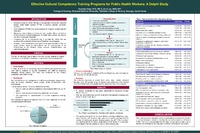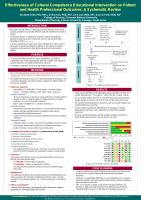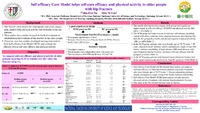| dc.contributor.author | Chae, Duckhee | en |
| dc.contributor.author | Lee, Chung Yul | en |
| dc.contributor.author | Kim, Suhee | en |
| dc.date.accessioned | 2013-10-22T20:32:59Z | |
| dc.date.available | 2013-10-22T20:32:59Z | |
| dc.date.issued | 2013-10-22 | |
| dc.identifier.uri | http://hdl.handle.net/10755/304292 | |
| dc.description | <p>24th International Nursing Research Congress Theme: Bridge the Gap Between Research and Practice Through Collaboration. Held at the Hilton Prague Hotel.</p> | en |
| dc.description.abstract | <p>Session presented on: Friday, July 26, 2013:</p>
<p><strong>Purpose:</strong> While health indices of smoking, hypertension, and diabetes among Korean adults have improved during the last 10 years, physical inactivity and obesity were getting worse. The purpose of this study was to determine whether self-efficacy, exercise benefits and barriers, and demographic factors have the same effects on the physical activity level across the gender.</p>
<p><strong>Methods:</strong> A cross-sectional analysis of the baseline data was conducted to examine 70 sedentary white-collar workers (35 male, 35 female) from a major airline company in Korea participating 8-week workplace physical activity intervention. Steps were measured using a Yamax CW-700/701 pedometer. Simultaneous quantile regression was used to identify the degree of homogeneity in the effects of self-efficacy, exercise benefits and barriers, and demographic factors on level of physical activity.</p>
<p><strong>Results:</strong> For male workers, exercise self-efficacy had a significant effect on physical activity, but only when respondents were at 10% (3431 steps/day, ?=109.0, p=.018) and 25% (4653 steps/day, ?=78.9, p=.044) quantiles. For female workers, marital status was significantly related to physical activity, but only when respondents were at 10% (3537 steps/day, ?=-2316.4, p=.013) and 25% (3862 steps/day, ?=-2286.3, p=.014) quantiles.</p>
<p><strong>Conclusion:</strong> This study findings highlight the heterogeneous physical activity determinants among white-collar workers. Therefore intervention strategies for increasing physical activity should be tailored to gender as well as degree of physical activity level.</p> | en |
| dc.format | Text-based Document | en |
| dc.language.iso | en | en |
| dc.subject | Workers | en |
| dc.subject | Exercise | en |
| dc.subject | Gender | en |
| dc.title | Do self-efficacy, exercise benefits and barriers, and demographic factors have the same effects on the physical activity across the gender? | en |
| dc.type | Presentation | en |
| dc.rights.holder | <p>
All rights reserved by the author(s) and/or publisher(s) listed in this item record unless relinquished in whole or part by a rights notation or a Creative Commons License present in this item record.
</p><p>
All permission requests should be directed accordingly and not to the Sigma Repository.
</p><p>
All submitting authors or publishers have affirmed that when using material in their work where they do not own copyright, they have obtained permission of the copyright holder prior to submission and the rights holder has been acknowledged as necessary.
</p> | en |
| dc.description.note | <p>Items submitted to a conference/event were evaluated/peer-reviewed at the time of abstract submission to the event. No other peer-review was provided prior to submission to the Henderson Repository.</p> | |
| dc.type.category | Full-text | en |
| dc.evidence.level | N/A | en |
| dc.research.approach | N/A | en |
| dc.contributor.department | Non-member | en |
| dc.author.details | Duckhee Chae, MSN, RN; Chung Yul Lee, PhD, RN; Suhee Kim, MSN, RN | en |
| dc.conference.name | 24th International Nursing Research Congress | en |
| dc.conference.host | Sigma Theta Tau International | en |
| dc.conference.location | Prague, Czech Republic | en |
| dc.date.conferenceyear | 2013 | |
| dc.description.reviewtype | Abstract Review Only: Reviewed by Event Host | en |
| dc.description.acquisition | Proxy-submission | en |





